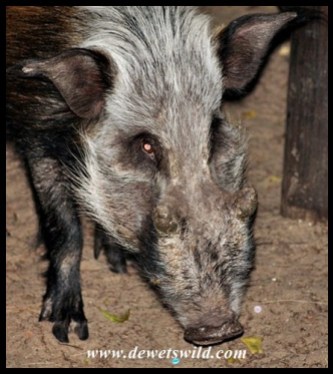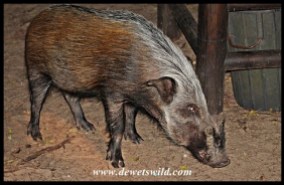Potamochoerus larvatus
By far the more secretive of the two wild pigs native to South Africa, the Bushpig is a shy denizen of forests, riverine thickets, reedbeds and other similarly densely vegetated habitats, in contrast with the warthog that prefers more open environments. They’re dependent on a reliable source of water. Also in contrast with the warthog, the Bushpig is nocturnal, rarely venturing out into the open to feed before darkness has fallen. They have a largely vegetative diet – roots, tubers, fungus, bark, seeds, pods, fruit, grass, water plants, etc. – but will also eat carrion, eggs, and even small vertebrates ranging from frogs to the young of antelope. Their omnivorous tendencies also extend to farm produce, and apart from chewing off the stems of banana and papaya trees to get to the fruit and laying waste to maize crops they’ve also been recorded as feasting on chickens, sheep, goats and even domestic pigs!
Bushpigs are social animals, moving around in family groups called sounders usually numbering around ten animals and consisting of a single, dominant, adult boar, a dominant sow, other sows, and their youngsters. They are great swimmers, fast runners and highly intelligent, making them difficult to trap. Despite their retiring nature, bushpigs are aggressive and deadly when cornered or protecting their young. In the wild only leopards and lions dare to tangle with them, and many a hunting dog, and hunter, have been lost to their slashing tusks.
Baby Bushpigs are usually born in the spring and summer months after a four month gestation. Litters number up to eight, but four is more usual. The piglets are weaned at about 4 months of age. Fully grown, adult stand between 60cm and 1m tall at the shoulder, with the sows, at an average of 60kg being considerably less bulky than the boars which may weigh up to 130kg! In the wild Bushpigs have a life expectancy of between 12 and 20 years.
The Bushpig has a wide distribution over southern, central and eastern Africa as well as Madagascar, where it was probably introduced by humans. In South Africa, where their population is estimated at over 10,000 animals, the Bushpig is found in the provinces in the north and east of the country – Limpopo, Mpumalanga, Gauteng and Kwazulu-Natal – with a separate population found in the Garden Route and the valley bushveld of the Eastern Cape. The IUCN considers the species to be of least concern, despite threats to their habitat and being hunted for destroying agricultural crops – a testament to their rapid rate of reproduction and adaptive nature.
During our visit to Cape Vidal in the iSimangaliso Wetland Park in January of this year, there was neither hide nor hair to be seen of Bushpig in the camp during the day. Under cover of darkness however they’d emerge from their hiding places in numbers, being regularly caught by the little camera trap we set up outside our cabin as they foraged in the open terrain.
We also encountered this sounder of Bushpigs just after sunrise one morning during our visit to Cape Vidal. Their reaction was typical of the species – while they were feeding overnight out in the open, at the first sight of humans they made a bee-line straight for the swamp forest.




















Unless habituated, they do seem to want to disappear asap when spotted, though of course they can be aggressive when threatened (like many animals). When you say there are records of them feasting on sheep, goats and domestic pigs I imagine this would be in the form of carrion? There are many rural (in parallel to urban) legends out there!
LikeLiked by 1 person
I agree that the thought of bushpigs actively hunting livestock may sound like the stuff of legend, but as it is mentioned in several guide books by notable authorities as well as in the 700+ page dissertation by Seydack and that edited by Kerley, Wilson and Balfour I thought it interesting enough to include here. Being omnivores, there is probably little doubt that they will feed on livestock carcasses, and knowing their belligerent reputation it doesn’t stretch the imagination too much to think that if bushpigs were then to find their way into a pen or sty with live versions of things they’re already used to eating the results would be gory…
https://scholar.sun.ac.za/handle/10019.1/19406 & https://anchorenvironmental.co.za/sites/default/files/2018-11/PREDSA%20eBook%202018.pdf
LikeLiked by 1 person
Thanks so much for the links especially to ‘Livestock predation and its management in South Africa’ – it is extremely interesting.
LikeLiked by 1 person
Great shots, Dries. I love your sneaky night captures. Very cleverly done. 👏🏻
LikeLiked by 1 person
Thanks Sylvia! Credit goes to our little camera “watchman”.
LikeLiked by 1 person
Okay…so I am always commenting on how beautiful the subjects of your pictures are…I think I shall have to withhold such comments on this one! Maybe a face only a mother could love?
LikeLiked by 1 person
😀
Bushpigs aren’t known for their sensitive personalities, so I don’t think this boar would mind in the least, Kathy – in fact he’d probably consider it a compliment!
LikeLike
You’re probably right!
LikeLiked by 1 person
I love that last photo, Dries.
LikeLiked by 1 person
Thank you very much, Tracy!
LikeLiked by 1 person
Bushpigs have a reputation for being both dangerous and destructive. Reading your description of them it is easy to see why. How exciting to see them both on your trail camera and out in the open.
LikeLiked by 1 person
We’re always excited when we get to see them, Anne, and though we do try and keep a safe distance when on foot we’ve had a few unexpected close encounters at a few places while moving around our accommodation at night.
LikeLike
Interesting! In Arizona, they have javalinas that are wild. Technically they aren’t a pig, though they look like they could be. They are from the peccari family.
LikeLiked by 1 person
Amazing that the peccaris and javalinas look so much like pigs, but aren’t!
LikeLiked by 1 person
Indeed, they are hard to tell apart by the layperson.
LikeLiked by 1 person